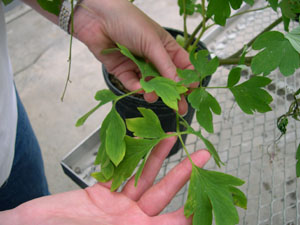Description

Yellow sticky card in production space. (photo courtesy of Marci Spaw)
Maria follows the scouting and monitoring methods and as described in an Extension Fact Sheet from Oklahoma State University Cooperative Extension Service (linked at right). By maintaining accurate records, she is able to refer to them when problems arise and build a database of pests, crop preferences and yearly population cycles.
Maria knows from experience that the symptoms of puckering that she begins to observe by February 6 on the youngest foliage might be related to insect feeding damage from plant-feeding pests like aphids, thrips or some mite species. The pest-scouting records Maria kept for the dicentra crop are linked at right. Concerned that insect damage may be causing the problem, she went to the greenhouse to thoroughly inspect her crop. She wanted to make sure that she was not missing a pest that could causes damage and may not show up on the sticky cards, such as non-flying pests like two spotted spider mites and aphids (which do not develop wings unless the infestation is heavy).
Results

Maria inspects the leaves of the dicentra crop. (photo courtesy of Marci Spaw)
Maria found no alarming insect populations on either healthy plants or plants that were showing the symptomology. Fungus gnats and shore flies were present, however, no mites, aphids, thrips or whiteflies were detected.
Download IPM – Scouting and Monitoring for Pests in Commercial Greenhouses Download Dicentra Sticky Card Record



